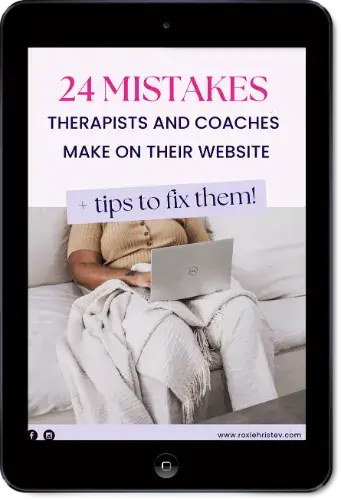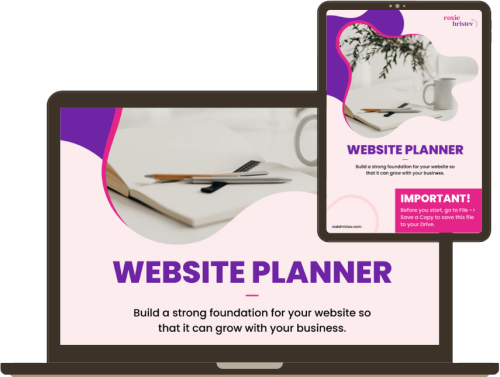Your website is more than just a virtual business card. It’s the gateway to your therapy or coaching practice, the first point of contact for potential clients, and the platform through which you will build your online presence. It’s important to get it right and make a great first impression, as this will set the tone for your entire online presence.
While choosing a domain name and selecting a hosting provider are important considerations, the focus of this article is on the design elements that will make your website stand out and engage potential clients. We’ll dive into the five website design basics that every therapist or coach’s website should include helping you create a website that accurately reflects who you are and what you do, and that will build trust with potential clients.
In the therapy and coaching world, building trust is key. Your website is the first step in that process, and by incorporating these website design basics, you’ll be well on your way to creating a website that will attract the right clients and help you to build a successful and fulfilling career.
So, ready to give your website a boost? If you plan on building a new website or revamping an old one, make sure you’ve got these website design basics covered for a sparkly online presence.
Your photo, front, and center
People want to know who they’re potentially entrusting with their emotional well-being, and a picture is worth a thousand words. Make sure it’s a high-quality photo that represents you and your brand well. And don’t be afraid to show your personality in it, whether that means a friendly smile or a more serious expression.
Your photo is one of the most essential elements of your website, as it provides a human touch and helps to build rapport with potential clients. When people are looking for a therapist or coach, they want to see a friendly face they can relate to and feel comfortable with. By including a high-quality photo of yourself on your website, you can help to build trust and establish a personal connection with your clients before they even step into your office.
Make sure the photo you use is a recent and professional headshot that accurately represents you and your brand. Wear clothing that you would wear to a session and choose a background that complements your outfit and personality. If you’re unsure about what to wear or what kind of background to choose, consider hiring a professional photographer who specializes in headshots for therapists and coaches.
In terms of expression, you can choose a friendly smile or a more serious expression depending on your personality and the tone you want to set for your practice. A friendly smile can help to put potential clients at ease and convey a warm, approachable demeanor. On the other hand, a more serious expression can help to convey professionalism and expertise. Ultimately, the most important thing is that your photo accurately represents who you are and the kind of therapist or coach you are.
In short, your photo is an opportunity to make a great first impression and build trust with potential clients. Make sure to invest time and effort into choosing the right photo and presenting yourself in the best possible light.
A clear and concise message
Your website should clearly communicate what you do, who you help, and how you can help them. Be mindful of the language you use and make sure it’s easy to understand. Avoid therapy lingo that only therapists would understand and keep your message simple and to the point.
A clear and concise message is key to ensuring that your website effectively communicates what you do and who you help. Think of your website as a virtual brochure for your therapy or coaching practice, and make sure that it answers the questions that potential clients might have.
When crafting your message, be mindful of the language you use. Avoid therapy lingo that only therapists would understand, as this can be confusing and off-putting to potential clients. Instead, use simple language that is easy to understand and focuses on the benefits you offer.
Your message should clearly communicate what you do, who you help, and how you can help them. For example, instead of saying, “I’m a licensed therapist with a specialty in CBT,” you could say, “I help people overcome anxiety and depression by using evidence-based techniques like Cognitive Behavioral Therapy (CBT).” This conveys the same information but in a more accessible and user-friendly way.
In addition, your message should be concise and to the point. Potential clients are likely to have short attention spans, so make sure that your message is brief, easy to read, and quickly communicates the value you offer. Use clear headings, bullet points, and concise paragraphs to make your message easy to digest.
In conclusion, a clear and concise message is essential to effectively communicating what you do and who you help. By using simple language and focusing on the benefits you offer, you can help potential clients understand how you can help them and build trust with them before they even pick up the phone to book a session.
A user-friendly design
Your website should be aesthetically pleasing and easy to navigate. Use clear headings, bullet points, and concise paragraphs to make the information easy to read. And make sure your website is optimized for mobile devices, as more and more people are using their phones to search for therapists and coaches.
A user-friendly design is essential to ensure that your website effectively communicates your message and provides a positive experience for visitors. A website that is aesthetically pleasing and easy to navigate can help to build trust and establish your credibility as a therapist or coach.
Clear headings, bullet points, and concise paragraphs are all key elements of a user-friendly design. They help to make the information on your website easy to read and understand, and they also make it easier for visitors to find the information they’re looking for. Be sure to use a font that is easy to read, and choose a color scheme that complements your brand and appeals to your target audience.
In addition, it’s important to make sure your website is optimized for mobile devices. With more and more people using their phones to search for therapists and coaches, it’s crucial to ensure that your website is mobile-friendly and provides a seamless user experience on any device. This means using responsive design techniques that allow your website to adapt to different screen sizes and devices, and using clear and concise language that is easy to read on a small screen.
Finally, it’s important to make sure that your website loads quickly, as visitors are likely to abandon a website that takes too long to load. You can use tools like Google PageSpeed Insights to test your website’s loading time and identify any areas for improvement.
A user-friendly design is essential to ensure that your website effectively communicates your message and provides a positive experience for visitors. By using clear headings, bullet points, and concise paragraphs, optimizing for mobile devices and ensuring that your website loads quickly, you can help to build trust and establish your credibility as a therapist or coach.
Find out 24 mistakes therapists and coaches make on their DIY website!
This guide is all about the mistakes you can avoid doing on your website and offers you tips on how to fix them too, so you can grow your practice and connect more easily with your clients.

Testimonials and social proof
Nothing says “I’m trustworthy” like a glowing testimonial from a past client. Make sure to include testimonials on your website and use social proof, such as the number of clients you’ve helped or awards you’ve won, to build trust with potential clients.
Testimonials and social proof are powerful tools for building trust with potential clients. People want to know that others have had positive experiences with you, and testimonials from past clients can be incredibly persuasive.
Make sure to include testimonials on your website that highlight the specific results and benefits clients have experienced from working with you. Be sure to include the client’s name, and consider including a photo if possible, to add credibility and personalize the testimonial.
In addition to testimonials, social proof can also be used to build trust with potential clients. This can include the number of clients you’ve helped, awards you’ve won, or media mentions you’ve received. By showcasing these metrics, you’re demonstrating your experience and expertise, and helping potential clients to see that you have a track record of success.
When using social proof, be sure to use clear and concise language that communicates the value you offer. For example, instead of saying, “I’ve helped hundreds of clients,” you could say, “I’ve helped hundreds of people overcome anxiety and depression and achieve their goals.” This conveys the same information but in a more engaging and user-friendly way.
In conclusion, testimonials and social proof are powerful tools for building trust with potential clients. By showcasing the positive experiences of past clients and demonstrating your experience and expertise, you can help potential clients see that you’re trustworthy and capable of helping them achieve their goals.
A clear call to action
What do you want visitors to do when they land on your website? Do you want them to book a session with you? Sign up for your newsletter? Whatever it is, make sure there’s a clear call to action that’s easy to find and follow.
A clear call to action (CTA) is a critical element of your website design, as it tells visitors what you want them to do next. Whether you want them to book a session with you, sign up for your newsletter, or take some other action, a clear CTA is essential to guiding visitors toward your desired outcome.
When crafting your CTA, be sure to use clear and concise language that is easy to understand. Avoid using technical jargon or overly complex language, and instead, focus on communicating the value that the visitor will receive by taking the desired action.
In terms of placement, your CTA should be easy to find and follow. Consider placing it in a prominent location on your homepage, such as above the fold or in the header, so that it’s visible to visitors as soon as they arrive on your website. Additionally, consider using contrasting colors or bold text to make your CTA stand out and draw attention.
Finally, make sure that your CTA is actionable and leads to a well-designed landing page or form that provides a clear next step for the visitor. This could include booking a session with you, signing up for your newsletter, or filling out a contact form. The goal is to make it as easy as possible for visitors to take the desired action, so be sure to keep the process simple and straightforward.
A clear call to action is an essential element of your website design. By using clear and concise language, placing your CTA in a prominent location, and providing a well-designed landing page or form, you can guide visitors toward your desired outcome and help them take the next step with you.
Final thoughts about website design basics
Your website is often the first impression potential clients will have of you and your therapy or coaching practice, so it’s essential that it accurately reflects who you are and what you do. The website design basics outlined in this article—a professional photo, a clear and concise message, a user-friendly design, testimonials and social proof, and a clear call to action—will help you to create a website that will attract the right clients and set the stage for a successful and fulfilling career.
Having a high-quality photo that represents you and your brand well, clearly communicating your services and how you can help your clients, and making sure your website is aesthetically pleasing and easy to navigate, are all critical components of a successful website. Adding testimonials from past clients and using social proof to build trust with potential clients can also help to increase your credibility and create a more engaging user experience. Finally, a clear call to action that is easy to follow will guide visitors toward taking the next step with you.
In conclusion, your website is an essential part of your therapy or coaching practice, and taking the time to get it right will pay off in the long run. By including these five website design basics, you’ll be well on your way to creating a website that accurately reflects who you are and what you do, and that will attract the right clients and help you to build a successful and fulfilling practice. And don’t forget, if you need help implementing this on your website, you can contact me here.
GET A FREE website planner
This Website Planner is going to help you get super clear, and organized and help you and your web designer avoid all the newbie mistakes that keep web design projects dragging on and on forever!






